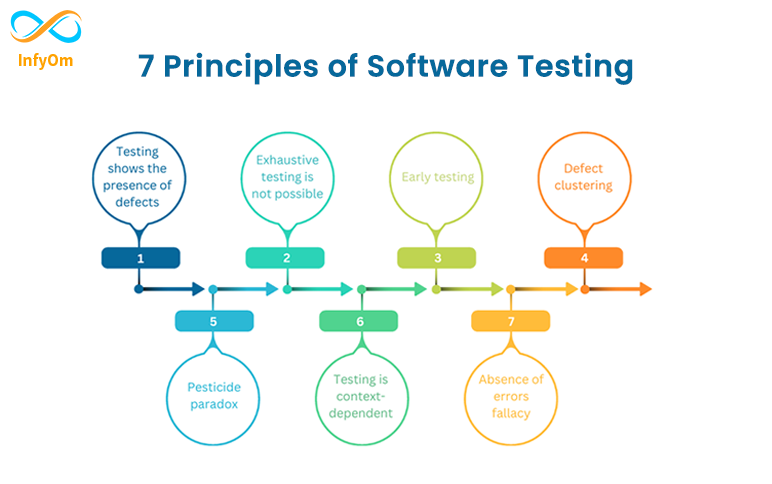Software testing is the most common way of executing a program determined to track down the blunder. Our software needs to be error-free in order to perform well. The software will be free of all errors if the testing is successful.
7 Principles of Software Testing
There are seven principles of software testing as below:
- Testing shows the presence of defects
- Exhaustive testing is not possible
- Early testing
- Defect clustering
- Pesticide paradox
- Testing is context-dependent
- Absence of errors fallacy
- Principles of Software Testing

1) Testing shows the presence of defects
The application will be tested by the test engineer to ensure that there are no bugs or defects. During testing, we can only determine whether the software or application contains any errors. The majority of testing should be able to be traced back to the customer’s requirements, which means finding any flaws that might prevent the product from meeting the customer’s needs. This is the primary goal of testing, which uses a variety of methods and testing techniques to count the number of unknown bugs.
We can reduce the number of bugs in any application by testing it. However, this does not guarantee that the application is free of defects; software may appear bug-free after multiple types of testing. However, if the end-user encounters bugs that were not discovered during the testing process, they will be fixed at the time of deployment on the production server.
2) Exhaustive Testing is not possible
During the actual testing process, it sometimes appears to be very difficult to test all the modules and their features with effective and ineffective combinations of the input data.
As a result, rather than carrying out extensive testing, which necessitates endless calculations and results in failure for the majority of the effort, Because the product timelines prevent us from carrying out such testing scenarios, we are able to complete these variations based on the importance of the modules.
On-demand software testing pricing
3) Early Testing
In this context, “early testing” refers to all testing activities that should begin in the “requirement analysis stage” of the software development life cycle in order to find defects. This is because if we find bugs early enough, they can be fixed right away, which may save us a lot of money over bugs that are found later in the testing process.
We will need the documents for the requirement specification in order to carry out testing; Therefore, rather than addressing the issue at a later stage, such as the development phase, if the requirements are incorrectly defined, they can be addressed immediately.
4) Defect clustering
During the testing process, we can identify the number of bugs that are correlated to a small number of modules using defect clustering. This is due to a number of factors, including the modules’ potential complexity; The coding might be hard, and so on.
The Pareto Principle, states that we are able to identify that approximately, will apply to these kinds of software or applications. Twenty percent of the modules contain eighty percent of the complications. We can find the uncertain modules with this, but if the same tests are running on a regular basis, this method can be difficult, and the same test won’t be able to find new defects.
5) Pesticide paradox
This principle stated that the software or application will not be able to detect new bugs if the same set of test cases is run repeatedly over a predetermined period of time. It is critical to frequently review all test cases in order to overcome these pesticide paradoxes. Additionally, new and distinct tests must be written for the implementation of multiple software or application components to aid in the discovery of additional bugs.
6) Testing is context-dependent
According to the context-dependent principle of testing, there are a variety of market sectors, including commercial websites, e-commerce websites, and so forth. Because each application has its own requirements, features, and functionality, there is a certain method for testing commercial and e-commerce websites. To check this sort of use, we will take the assistance of different sorts of testing, different procedure, approaches, and various strategies. As a result, the application’s context determines the testing.
Functional vs non-functional testing
7) Absence of errors fallacy
We can say that the application is 99 percent bug-free once it has been tested thoroughly and no bugs have been found before it is released. However, there is a possibility that if the application is tested alongside the incorrect requirements, flaws will be discovered, and they will need to be fixed within a certain time frame. This is because the testing is done on the incorrect specification, which does not correspond to the client’s requirements. According to the absence of error fallacy, if the application is impractical and unable to fulfil the requirements and needs of the client, then identifying and fixing bugs would not be helpful.



